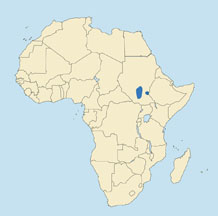 |
Kobus megaceros
Lechwe del Nilo (Sp), Weissnacken-Moorantilope (G), Cobe de Mrs. Gray (F). Also called Mrs. Gray's lechwe after the wife of J. E. Gray of the British Museum. In 1859, Dr. Gray attempted to name it Kobus maria for his wife, Maria; however, it had already been "discovered" in 1853 by Austrian zoologist M. T. von Heuglin and given the name Kobus megaceros in 1855. The common name, however, has stuck.
DESCRIPTION Shoulder height 38-40 inches (96-102 cm). Weight 200-265 pounds (90-120 kg).
The Nile lechwe is a handsome, medium-sized antelope, appearing black at a distance, with a large white shoulder patch and very long, S-shaped horns. The body is somewhat smaller than that of the common lechwe. General color is blackish brown, with shoulder patch, nape of neck, ears and underparts white. There are white markings around the eyes and on the muzzle and chin. The tail is long. The coat is rather long and rough. Hoofs are elongated and spread out, and the underside of the pasterns is hairless, which are adaptations to swampy habitat. Horns (males only) are strongly ringed, long and thin, and form a pronounced double or S-shaped curve. The female is smaller, without horns, chestnut fawn in color, and without the white shoulder patch or nape stripe.
BEHAVIOR Gregarious, living in herds of 50 up to hundreds, or even more in loose bands. Males often form separate groups close to the main herd. Diurnal, but with most activity early and late in the day. Feeds on grasses and aquatic plants, drinks frequently. Eyesight and hearing are good, sense of smell only fair. Swims well. Unable to run fast on dry land. Life expectancy about 10 years.
HABITAT Swamps.
DISTRIBUTION Swamps of the White Nile, Bahr-el-Ghazal and Sobat rivers in southern Sudan, and swamps of the Baro and Ghilo rivers in extreme western Ethiopia.
REMARKS Nile lechwe are handsome animals with beautiful horns. Depending on the water level, they may be found deep within a swamp, close to the edge, or sometimes even outside on dry ground where they can be approached by hunting car. A lechwe encountered outside a swamp, or even at the edge, is not difficult to take; however, the hunter misses the rich experience of a classic Nile lechwe hunt. For this, he must penetrate deep within the swamp on foot, wading waist-deep in murky water, attempting to balance atop floating islands of papyrus (and inevitably falling through), and being whipped by reeds and bitten by ants and leeches-all at high levels of temperature and humidity. Shooting a good Nile lechwe in the reeds is a difficult proposition, but, when a herd is eventually encountered on a piece of dry ground, it is not. The hunter should be in shape for the swamp, and is strongly advised to engage a local Dinka (who is taller and more surefooted than he) to carry his rifle, camera and anything else he would like to keep dry. (Sadly, the ongoing civil war in Sudan has prevented hunting there since 1983.)
|





